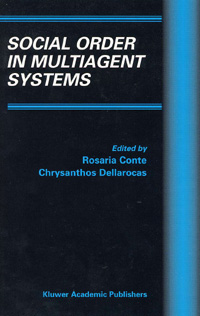Reviewed by
Bruce Edmonds
Centre for Policy Modelling
Manchester Metropolitan University
Manchester, UK

The utility concept of motivation has been extremely influential in general, but in particular among social simulators and the agent community. It is more often the case than not that when one examines a published agent mechanism or social simulation, there is some numerical measure of success that is pivotal to what an agent does. In effect that agent is choosing actions or plans according to which does better on this measure. This approach permeates machine learning algorithms, theoretical models and planning as well as (more obviously) decision-making.
This book considers one of the main alternatives to this approach - social norms. It is concerned with how these norms might act upon agents and thus influence or control their behaviour (and by implication that of all social actors). A norm is essentially a sort of law (institutionalised or otherwise) which society imposes (or attempts to impose) upon individuals to constrain or direct them. Part of the difficulty with this idea is its very familiarity - we are all so well versed in the norms of the societies we inhabit that we do not often consciously think about them. That is to say that the operation of norms often describes the range of actions we choose between - we do not even consider the full range of possible actions but only the acceptable ones. Further, norms are often not explicitly defined or communicated but rather learnt as a result of experience and observation. They are often vague or fuzzy. Norms are thus not easy to write down exactly and this makes them somewhat difficult to study.
This book aims to "dig down" into the idea of norms and explores the possible ways that they might be formed, transmitted and act upon us. It is thus primarily a philosophical exploration of what norms are or could be, backed up with arguments and examples as well as a few simulations. Although, ostensibly, the target of this book is to consider how norms might be represented in multi-agent systems, almost all of the discussion in the book is more widely applicable than that. In a sense, the context of multi-agent systems is used to free the authors from only considering human norms. Thus a greater range of possibilities is assessed and the text is freed from the constraints of existing academic traditions (for example the involved and intricate philosophy of rights and obligations). This "computational stance" also helps to reify the discussions, so that a greater focus is directed at feasible mechanisms than would otherwise be the case. This "reification" of the philosophy has the effect of shifting the arena from psychology to cognitive science and Artificial Intelligence.
All academic fields and sub-fields have their own "house styles" for illustration, presentation and exposition. Game theoretical approaches pervade presentations of work that uses utility-based mechanisms. In the realm of agents and norms, formal logics rule - in particular logics that are related to the deontic and modal formalisms developed in philosophical logic over the last 50 years. That is not to say that these logics are used to actually prove anything, but rather as a sort of philosophical "lingua franca". This is supposed to make the ideas that are explained in natural language precise, but (speaking as a person well versed in formal logic) I do not think that it has this effect in practice. Fortunately the formalisms in this book are almost entirely supplementary to the text except as a short hand way of referring to entities introduced. Thus if you read the book and keep track of what the letters stand for, you can safely ignore the content of the formulae. It is possible that the detail in the formulae might be used by someone trying to implement an agent, but since there are adequate natural language descriptions of the mechanisms concerned, this seems unlikely.
The philosophical style of this book results in both its strengths and weaknesses. On the plus side, if you want a thorough exploration of the possible ways in which norms might be represented and operate, augmented by a discussion of the surrounding arguments and issues, this is an excellent book. So if you are thinking of implementing norms or norm-like mechanisms in your simulation or agent, this book will take you through the possibilities. On the other hand, if you want to know what the effect of certain kinds of norm-like mechanism will be in a society of agents (for example how good the various approaches are), you will be somewhat disappointed. This lacuna exists, to a large extent, because mapping the outcomes resulting from various norm-like mechanisms is still very much work-in-progress - please join in!
Return to Contents
of this issue
© Copyright Journal of Artificial Societies and Social Simulation, 2005